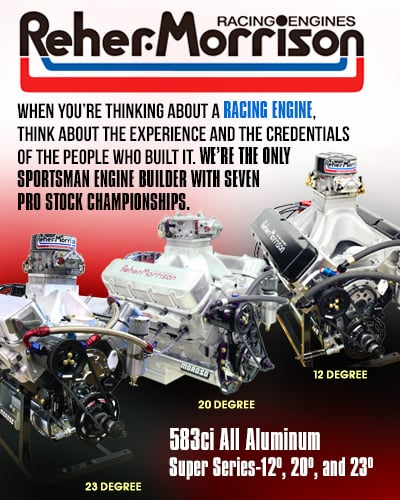HAPPY BIRTHDAY, CANOPY!
The modern cockpit canopy is 10 years old. It celebrated its birthday in Brainerd, Minn.
The bolt-on ballistic polycarbonate driver protection, which Don Schumacher Racing designed and engineered with help from Aerodine Composites debuted at this race in 2012. And it remains optional – and for some teams, questionable.
While some still aren’t convinced they would be safer with the canopy and others would argue that the device (particularly the latest edition) is an aerodynamic enhancement more than a life-saving component, others have said they wouldn’t race without it.
The concept of a canopy didn’t originate with Don Schumacher Racing. Don Garlits had experimented with his own version of one back in the early 1990s, but he referred to his as a “Pro Glass” and “Plexiglas” canopy. And this current one, which adds about 30 pounds to a dragster (something “Big Daddy” most likely wouldn’t have enjoyed), is not a resurrection of Garlits’ shield/canopy. There were others in the 1970s. The bulletproof DSR design is built with Kevlar and carbon fiber, is inspired by F-16 fighter jet technology, and is considerably thicker. It also comes with side protection, the ability to open from both the inside and outside, a fire-suppression system, and a fresh-air system similar to those used in Funny Cars.
Eight-time champion Tony Schumacher, the driver for whom the original canopy project was begun, naturally remains the biggest proponent. He said the canopy “is bulletproof. Parts are bouncing down the track. When Kenny Bernstein crashed [Round 2, October 1999, Memphis] and Scelzi crashed [Qualifying Session 1, June 2000, Joliet, Illinois] and their stuff was going in every direction over my car, I’d have killed to have [the canopy] on. Now I have an almost false sense of security, because it’s still a fast car. But it’s nice to keep that stuff out of your cockpit.
“When Scelzi crashed against me, his nose came around and my blower belt came off or he’s in my cockpit. When Bernstein crashed, his mags were bouncing over my tire. And I’ve hit two birds. [The canopy] is to divert that. It’s not for speed. It’s not for decoration. It’s for safety,” Schumacher said.
Even if privately, some drivers and crew chiefs challenge his assertion.
One who spoke on the record was Richard Hogan, crew chief for Steve Torrence. Their Capco Dragster team never has used the canopy. But Hogan said he isn’t persuaded that the canopy isn’t an aerodynamic asset. He said of the latest version of the canopy that’s noticeably wider and flatter, “There’s not supposed to be, but there’s probably an aero advantage, because they let them change the design and they haven’t really policed it. At some point, you might have to run a canopy just because it hasn’t been policed properly. With the original version, I don’t think there was an advantage, but there is with the newer version.”
 Besides, Hogan said, a switch to one now, even if Torrence wanted that, would be too pricey: “We just never pursued it, because we’d have to change everything. We have five cars we’d have to retrofit... and the extra weight... It’d be a lot of work. And it’d probably cost $20,000 a car.”
Besides, Hogan said, a switch to one now, even if Torrence wanted that, would be too pricey: “We just never pursued it, because we’d have to change everything. We have five cars we’d have to retrofit... and the extra weight... It’d be a lot of work. And it’d probably cost $20,000 a car.”
Mike Green, now tuner for Justin Ashley’s Phillips Connect/Vita C Dragster, orchestrated the project starting in 2010, when he was crew chief for Tony Schumacher’s U.S. Army Dragster. And he still contends that the canopy gives the driver “a slight performance disadvantage because of the weight,” which he estimates has come down to “20 or 30 pounds” of additional weight on the car.
“We made the initial one and took it to West Palm Beach, and it weighed, like, 100 pounds,” Green said. “But we put it on the car and Tony got in it and drove it and he said, ‘I like it.’ That was the first thing—if he didn’t like it, we were never going to do it. But he said, ‘I like it,’ so then we went to building a more competitive one, and it has just evolved, evolved, evolved.
“It took a couple of years to get a competitive one [as lightweight as possible]. Then it took another year for the NHRA to let us run it. It was a year of aero testing and a lot of stuff to convince—I don’t necessarily think it was the NHRA but the rest of the competitors—that it wasn’t an advantage,” he said.
After all, his motive for bringing the innovative boat-racing design to Don Schumacher’s attention was safety. Green said his interest turned from a “Hmm, this is interesting” mentality to one of “We ought to do something” following the 2010 racing death of Top Alcohol Dragster driver Mark Niver at Seattle. He said he thought, “If there’s anything we can do to make [the sport] safer, we need to probably do it. So that started the whole process.”
Antron Brown certainly is qualified to speak to the effectiveness of the canopy after massive crashes in 2013 and 2014, and he vouched for it.
Following his second-round accident at the 2013 Winternationals – when his engine exploded at the end of a 308-mph pass, the car broke apart in fiery fury, and he ended up on his side in the sand – Brown said, “The windshield is five-eighths-of-an-inch thick. Nothing got to me. When I hit the sand trap, I saw stones flying all over the place, but I didn't get dusty. Nothing got into me. It really, really did its job. Thank God that canopy is on our car, because when we hit that sand trap it really kept everything away from me and the fire away from me. I don't know what would've happened if we would've had [the traditional, open-cockpit] set-up on the front of the car.
The following May, at Atlanta, the three-time champion testified that the canopy protected him as advertised following a similar-looking wreck in Friday night qualifying.
Another beneficiary of the canopy is Leah Pruett. She escaped unhurt from her wicked airborne accident at St. Louis in October 2020. Still shaken, she expressed her thanks for the canopy.
“Obviously, they work very well, and they have success with them,” Scrappers Racing crew chief Rob Flynn said.
His team-owner/driver, Mike Salinas, doesn’t race with a canopy affixed to his dragster. Flynn said, “All the teams I’ve worked with, it’s just not something they ran. It’s never been a [topic of] discussion. I think it’s a personal preference. It seems good either way. If you talk to Antron, he’ll tell you stories where parts would have hit him if he didn’t have the canopy. So that’s a wonderful thing. But other people, if it’s not what they choose to do, then that’s fine also.”
That’s why the canopy isn’t mandatory. And that doesn’t bother Green, who stands by the device that he spearheaded, with cooperation from his then-assistant Neal Strausbaugh, and Joe Veyette in 2010, in partnership with Aerodine Composites’ Craig McCarthy.
Green said, “A canopy dragster is safer than a non-canopy dragster.” But he shrugged and said, “When they first saw it, some people said, ‘I don’t want to drive that,’ and that’s the way they’ve been. It’s a personal choice. If they feel more comfortable driving without it, then that’s what they’re going to do. It’s nothing we planned on having every car do. We just wanted to have a safer car for Tony Schumacher. That’s what we set out to do.”
Team owner-driver Josh Hart doesn’t use the cockpit canopy on his R+L Carriers Dragster, but he said he’d like to make a test pass in a canopy car.
“I’ve heard they’re a lot quieter and [the ones who swear by the canopy] say they feel a lot safer. In Leah’s case, I’d say everything in that incident helped. I’d love to try one. I’m open. That’d be awesome,” he said.
For now, at least, Hart prefers the open cockpit. He said, “Based on what little experience I have with it, they say you can [find added performance] a little bit more through the middle [of the run without the canopy] because the car’s not as rigid. Brittany Force kind of makes that an anomaly, because she uses a canopy and she throws down at every racetrack. Maybe that was a rumor at the beginning of the canopy’s life.”
Hart said he keeps thinking about Brown’s crash, “where he was upside down or up against the wall. That’d be relatively scary. Then you’re kind of stuck until everybody gets to you, whereas we’ve got a little bit better chance of getting out with an open cockpit. But let’s be honest: If something happened at 330 miles an hour, all bets are off, anyway.”

“I don’t care if it looks ugly. The fact is I feel safer. It’s the smartest thing you can put on a car until we figure out something smarter,” Schumacher said.
“People say, ‘What if you’re on fire?’ IF my car is on fire and IF I’m knocked out and IF Safety Safari takes the weekend off and IF my fire bottles don’t work, I might get hot. This car goes 330 mph. I put on a firesuit. I get in a roll cage, and I wear a seat belt, because it’s a very fast race car and there’s a risk. I understand that. I’ve broken cars in half, and I don’t want to be on fire, but I trust in my safety equipment. It’s so much better than it used to be.”
Green said in retrospect, “We didn’t have a big budget, but we did fire tests. Especially when we were developing this, there were way more people getting burned from fire coming in the cockpit from the engine. We have to run a fire system. I wish every dragster had a fire system, because the fuel line goes right between your legs and the engine’s full of oil and the driver can get on fire. I really think it makes sense for all dragsters to have one.” It’s not mandatory for open-cockpit cars.
“I think it was a good thing,” Green said, “definitely a worthwhile project.”







































